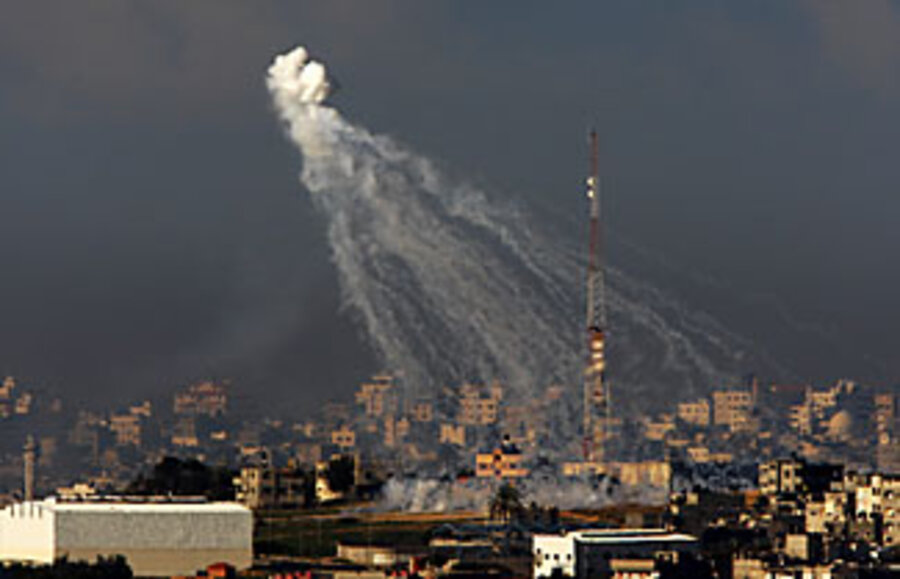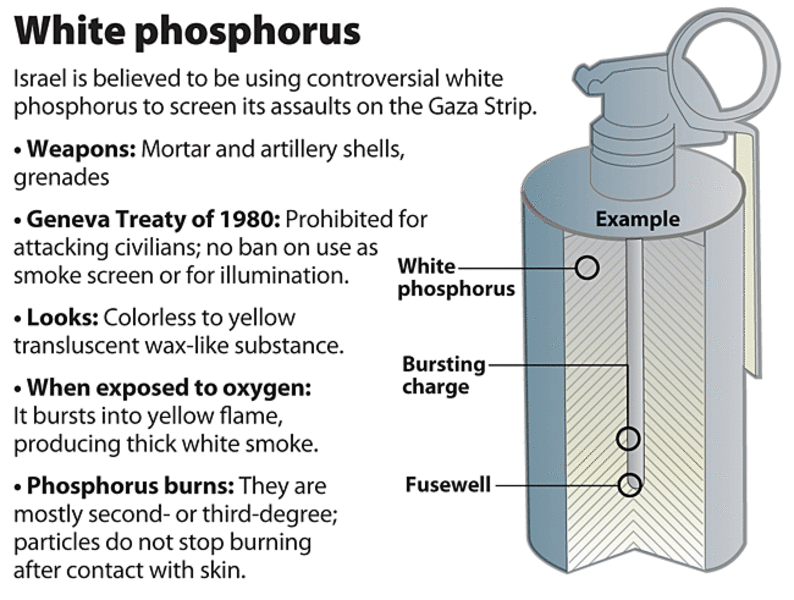Gaza: Israel under fire for alleged white phosphorus use
Loading...
| Paris; and Beirut, Lebanon
Marc Garlasco has been on the northern border of Gaza for the past five days watching what he says are white phosphorus munitions exploding over a crowded refugee camp.
Mr. Garlasco, a senior military analyst for New York-based Human Rights Watch (HRW), says that the way Israel is using the incendiary device is illegal. White phosphorus shells contain more than 100 felt filaments that ignite upon contact with the atmosphere, drift to earth, and burn intensely for at least 10 to 12 minutes.
The usage of white phosphorus is not illegal under international law if it's used in military operations as a smoke screen to cover troop movements or against bunkers, armored vehicles, and ammunition dumps. But its use is forbidden against people – civilians and soldiers alike – under nearly all military codes and laws.
"The use of white phosphorus is banned as a weapon that causes 'unnecessary suffering,' " says Mark Ellis, director of the International Bar Association in London. "It isn't to be used in civilian areas, or indeed against people since it creates horrible damage to the human body, and unnecessarily so."
Israel, which has been charged with using white phosphorus in Lebanon, says it is not using white phosphorus in its war against Hamas in Gaza, now in its 18th day.
"The IDF [Israeli Defense Forces] acts only in accordance with what is permitted by international law and does not use white phosphorus," IDF Chief of Staff Gabi Ashkenazi told Israel's Foreign Affairs and Defense Committee on Tuesday in response to a query.
But Garlasco says that phosphorus is clearly being used in the Jabaliya refugee camp, one of the most crowded areas in Gaza.
"I can see them; we are very certain, whatever the Israeli Defense Forces may say, that white phosphorus is being used. It was used by Israel in Lebanon in 2006, but not until the population fled. In Gaza, the population can't flee."
As the offensive continues, which has killed more than 900 people, a variety of European doctors in Gaza, human rights groups, news organizations like Al Jazeera, and observers on the border are reporting instances and sightings of weapons use that is causing deaths, and wounds they say they have not encountered before. Most are calling for access to Gaza to determine what is true amid a rage of reports and rumors.
While the phosphorus explosives are widely condemned for raining down indiscriminate harm, questions have also arisen about the possible use of another weapon called Dense Inert Metal Explosives, or DIME, that was created by the US Air Force. DIME is designed to be used in crowded urban areas since the weapons are highly lethal but have an extremely limited range of explosive force that can reduce collateral damage.
Norwegian doctor Mads Gilbert, who worked in Gaza's main Shifa hospital during the first weeks of the conflict, and who spoke to media in Egypt and Norway in recent days, is the main source for allegations of DIME use.
"This is a new generation of very powerful small explosive that detonates with extreme power and dissipates its power within a range of five to 10 meters," he told reporters. "There is a very strong suspicion I think that Gaza is now being used as a test laboratory for new weapons."
Al Jazeera, which has reporters in Gaza, has described hospital cases that appear to conform to the clean tearing of limbs that DIME can cause.
Italian scientists from the New Weapons Research Committee, which examines emerging military technology, said in a statement that "evidence is mounting" of DIME usage, saying the wounds may be "untreatable" due to metals like tungsten that enter the body. DIME is packed with tungsten dust that forms micro-shrapnel upon detonation.
Paola Manduca, a geneticist at the University of Genoa, says she has seen "four photos from Gaza hospitals since December that look like the effects of DIME. We want to stress as professionals that we need to be able to verify what is happening, and we can't do that if Gaza is blocked."
But Israeli experts deny any such usage of DIME by the IDF in Gaza. Shlomo Brom, former brigadier general who consulted international legal experts on weapons use as head of the IDF's Strategic Planning division, derided human rights groups' allegations on white phosphorus and DIME as political propaganda.
"The weapons itself are not illegal. Whether they are used in keeping with international law is a matter of interpretation. To judge you need all of the operational considerations and intelligence available. Of course, they don't have it, so they are playing a very irresponsible role," he says.
During the Lebanon war in 2006, Israel was suspected of employing depleted uranium munitions as well as DIME. The Israeli military has also used cluster bombs and phosphorous munitions in its previous battles in Lebanon.
It was heavily criticized by human rights groups for firing both kinds of munitions into the densely populated streets of west Beirut during the siege of the city in the summer of 1982.
In the 1990s, when Israeli troops occupied a border strip of South Lebanon, the distinctive cotton ball puffs of brilliant white smoke from exploding phosphorous rounds were a common sight in frontline areas. The Israelis used phosphorous to burn crops in frontline villages and to destroy ground cover used by Hezbollah fighters to infiltrate the occupation zone.
In August 1997, five Israeli soldiers burned to death during a battle with Lebanese guerrillas when they were trapped in a frontline valley by a brush fire ignited by phosphorous rounds fired by their own artillery.
HRW reported in 1996 that phosphorous shells fired by Israel had struck populated areas, causing civilian casualties, during a week-long Israeli air and artillery blitz in South Lebanon in July 1993. At the time of the 1993 attack, Maj. Gen. Herzl Bodinger, commander of the Israeli Air Force, was quoted by Israel's Yedioth Ahranot as saying: "We do not use such bombs."
But in 1994, the US State Department reported that there were "credible accounts of IDF [Israeli Defense Forces] use of phosphorous shells against military and civilians targets" in South Lebanon.
Other controversial armaments used by Israel in Lebanon included antipersonnel "flechette" rounds fired by tanks. The round is designed to explode in the air, showering the target with 5,000 three-centimeter-long steel darts in a cone-shaped trajectory some 900 feet long.
The United Nations recorded many instances of "flechette" rounds being used in South Lebanon in the 1990s in which civilians were killed or wounded.
Last year, Fadel Shanaa, a Reuters cameraman, was killed in Gaza by a "flechette" round fired by an Israeli tank that Mr. Shanaa was filming at the time.
Whether Israel is using white phosphorus illegally or not in its latest war against Islamist militants in Gaza, the issue may be gaining too much focus, says Garlasco from HRW, and could be "a red herring."
Sara Roy, a senior research scholar at the Center for Middle Eastern Studies at Harvard University, agrees.
"While it is important to pay attention to these weapons, the majority of Gazans are being killed by typical military operations. I am a scholar and I use words carefully, and this seems like a massacre."
• Joshua Mitnick contributed reporting from Tel Aviv.






